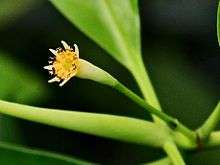Bruguiera parviflora
Bruguiera parviflora is a tree in the family Rhizophoraceae. The specific epithet parviflora is from the Latin meaning "small flowers".[3]
| Bruguiera parviflora | |
|---|---|
 | |
| Scientific classification | |
| Kingdom: | Plantae |
| Clade: | Tracheophytes |
| Clade: | Angiosperms |
| Clade: | Eudicots |
| Clade: | Rosids |
| Order: | Malpighiales |
| Family: | Rhizophoraceae |
| Genus: | Bruguiera |
| Species: | B. parviflora |
| Binomial name | |
| Bruguiera parviflora | |
| Synonyms[2] | |
| |
Description
Bruguiera parviflora grows up to 30 metres (100 ft) tall with a trunk diameter of up to 45 centimetres (18 in). The bark is pale grey to pale brown. The fruits measure up to 4 cm (2 in) long. The wood is sometimes used as charcoal or firewood.[3]
Distribution and habitat
Bruguiera parviflora grows widely in South Asia, Indochina, Malesia and northern Australia. Its habitat is mangrove areas and the species faces similar threats to those generally affecting mangrove habitats such as coastal development, pollution and climate change.[1][3]
gollark: Yes, yes, that's fairly obvious.
gollark: If there's an official golang twitter account, make it tweet "lol no generics".
gollark: Maybe make Donald Trump say weird but in-character things which he won't deny later for fear of looking stupid.
gollark: Oh, that's fun too.
gollark: If I found such an exploit and wanted to do moderately evil things, I would probably try and subtly influence Twitter's hive mind by fiddling with likes and such.
References
- Duke, N.; Kathiresan, K.; Salmo III, S.G.; Fernando, E.S.; Peras, J.R.; Sukardjo, S. & Miyagi, T. (2010). "Bruguiera parviflora". IUCN Red List of Threatened Species. 2010: e.T178821A7617234. doi:10.2305/IUCN.UK.2010-2.RLTS.T178821A7617234.en.
- "Bruguiera parviflora (Roxb.) Wight & Arn. ex Griff". The Plant List. Retrieved 1 August 2014.
- Madani, L.; Wong, K. M. (1995). "Bruguiera parviflora (Roxb.) Wight & Arn. ex Griff.". In Soepadmo, E.; Wong, K. M. (eds.). Tree Flora of Sabah and Sarawak. (free online from the publisher, lesser resolution scan PDF versions). 1. Forest Research Institute Malaysia. pp. 325–326, 327. ISBN 983-9592-34-3. Archived from the original (PDF) on 27 September 2013. Retrieved 1 August 2014.
This article is issued from Wikipedia. The text is licensed under Creative Commons - Attribution - Sharealike. Additional terms may apply for the media files.
